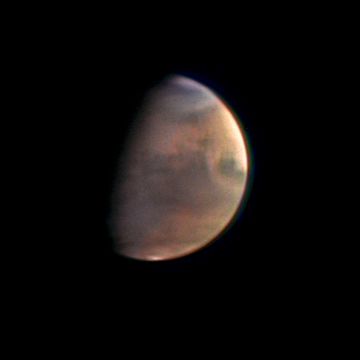A European spacecraft around Mars sent its first livestream from the red planet to Earth on Friday to mark the 20th anniversary of its launch, but rain in Spain caused some interference.
The European Space Agency broadcast the livestream with views courtesy of its Mars Express, launched by a Russian rocket from Kazakhstan in 2003.
It took nearly 17 minutes for each picture to reach Earth, nearly 200 million miles away, and another minute to get through the ground stations.
The transmission was disrupted at times by rain at the deep space-relay antenna in Spain.
🔴 Join us now for our @esaoperations #MarsLIVE livestream, one hour of live imagery from #Mars (we hope😉) 👇https://t.co/Ud6DwQH09J
Advertisement— ESA (@esa) June 2, 2023
But enough images made it through to delight the European space officials hosting the hour-long livestream.
The initial views showed about one-third of Mars, which gradually grew bigger in the frames before shrinking again as the spacecraft circled the planet.
White clouds could clearly be seen in some of the shots.
“If you were currently sitting on board Mars Express this is what you would be seeing,” said Simon Wood, the mission’s spacecraft operations engineer.
“We typically don’t normally get images in this way.”
Pictures and other data are usually stored aboard the spacecraft and later transmitted to Earth, according to Mr Wood, when the spacecraft’s antenna can be pointed this way.
Near real-time footage from so far away is “rather rare” said ESA.
The agency pointed to the live broadcasts by the Apollo moonwalkers more than half a century ago and, more recently, live snippets from spacecraft deliberately crashing into the moon and an asteroid.
“These missions were all pretty close to home and others further away sent perhaps an image or two in near real-time. When it comes to a lengthy livestream from deep space, this is a first,” ESA said in a statement before the event.
The rain on the plains in Spain cut into the number of pictures shown. ESA devoted only an hour to the livestream because it did not want to overload the spacecraft’s batteries.
Mars Express travelled to the red planet with a lander, dubbed Beagle-2, which lost contact with Earth as it attempted to touch down on the Martian surface.
More than a decade later, Nasa’s Mars Reconnaissance Orbiter captured pictures of Beagle-2.
Although it made it to the surface, the lander’s solar panels did not fully unfurl.







